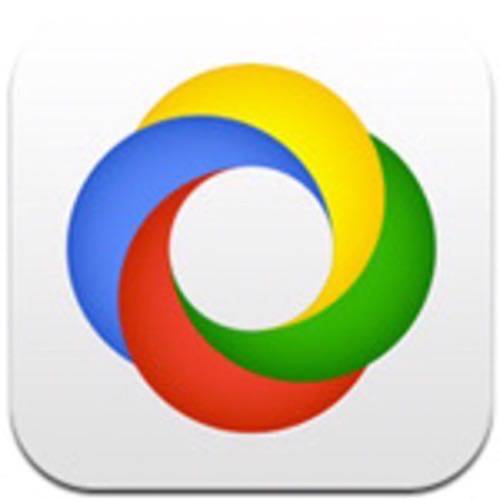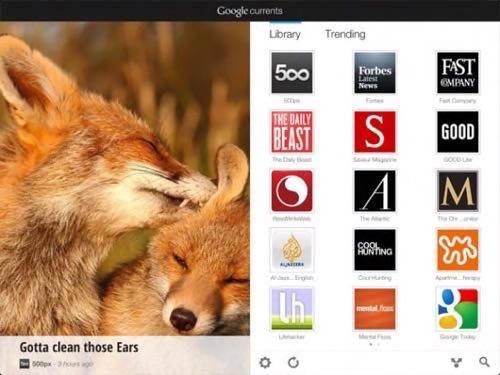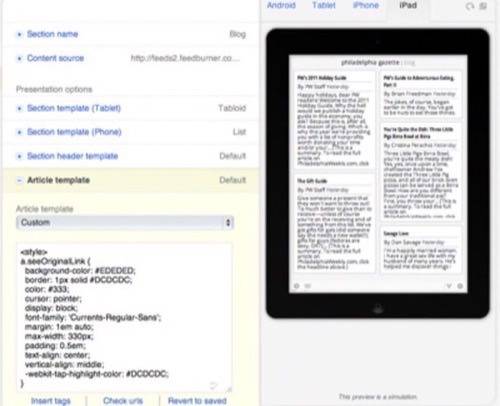Ending months of rumors, Google today launched its own personalized news-reading app for tablets and smartphones. Google Currents, as it’s called, is an app for iOS and Android that presents content from magazines, news sites and blogs in a format that’s far more digestible on mobile devices.

It lands in a somewhat crowded space occupied by offerings from Yahoo and AOL as well as from startups like Flipboard, Flud, Pulse and Zite, which was acquired by CNN earlier this year. Even before today’s launch Google Currents was billed as a potential “Flipboard killer.” After taking Google’s new app for a spin, we’re not convinced it poses a credible threat.
To be sure, Google Currents is a much more ideal way to consume written content from the Web on a tablet or smartphone. Its design is clean and to-the-point and the selection of content is virtually limitless.

A Decent – But Not Mindblowing – User Experience
When you first open up the app, it asks you to sign in with a Google account. Some may not be comfortable with this requirement, but we imagine that, in theory, it can help the app learn more about what content is best for you. As a bonus, it automatically pulls in your Google Reader feeds, which can add to your library of content one by one. Still, it would be nice if Google would let you use the app without logging in, or at least gave a clear explanation as to why doing so is required.
Once inside, you can browse content from a variety of pre-selected partners or search for just about any public RSS feed to add. We searched for one of our local alternative weekly newspapers, and sure enough Currents found all of the RSS feeds they publish.
Each publication has an “Add for free” button next to it, which suggests that charging for access to some content could be one way that Google and its publishing partners plan on monetizing the app in the future.
The article pages each have the sort of stripped-down, no frills layouts we’ve come to expect from this kind of application. Beyond that, there aren’t too many bells and whistles here. While Google Currents offers a better user experience for reading content than a tablet’s Web browser does, the standard for this kind of app has already been set pretty high.
Lackluster Social Features
Compared to its predecessors, the app is short on social integration. When you’re reading an article, for example, hitting the share icon pulls up a menu with three options: +1, Email and “More.” It’s under “More” that you can find options like Twitter, Facebook, Tumblr and Instapaper. In other words, all the most beloved social services the Web has to offer are buried two taps away, while sharing on Google’s own fledging social network is, naturally, the first option.

Part of the appeal of Flipboard is that it hooks into Twitter, Instagram, Facebook, Tumblr and a variety of other social networks and pulls content from them to build out a sort of socially-curated magazine. That’s not what Google is going for with this app. Instead, it works more like a glorified RSS reader with popular media brands hanging in the front window.
At first glance, there doesn’t appear to be an easy way to comment on articles. That’s not typically built all the way into this kind of app, but at least on Flipboard you can easily tap through to the original article on the Web if you want to chime in with a comment.
Awesome Tools For Publishers
What Google’s app lacks in terms of user experience and social integration it may well make up for with its self-serve tools for publishers. Google Currents Producer lets bloggers and news site publishers build out and customize their presence on the app. This includes adding custom RSS feeds and content sections, ingesting YouTube videos and customizing the look and feel of the publication.
The customization options include adding branding and other images, pulling in social network updates and even fine-tuning the design of article pages with custom CSS. From the same browser-based management console, one can also preview how their Currents module will look on a variety of devices. If a basic, on-screen preview isn’t enough, they also offer one-time use QR codes that allow the module to be tested within the actual app running on a supported device.

Another advantage of this being a Google product is that it integrates directly with Google Analytics, which allows publishers to collect page view data, something Flipboard and its competitors don’t currently support.
These tools are really powerful and they’re the kind of thing that many publishers would pay for, especially if they were available as a white-label way to build out their own stand-alone native or Web apps for tablets and smartphones.
Overall, Google Currents is a start. When compared to existing products, it doesn’t quite shine. For Android users who are still waiting to see what all the Flipboard-related buzz is about, this is definitely a viable alternative. That said, Google could stand to learn more from its newfound competitors, who for their part, could steal a page or two from Google’s own playbook when it comes to catering to publishers’ needs.










